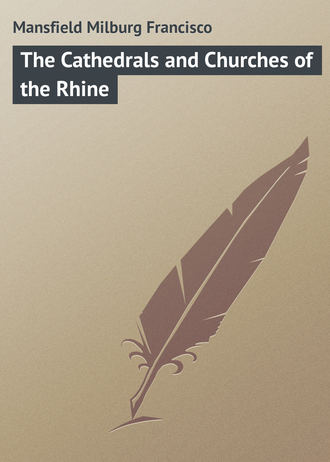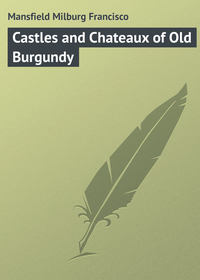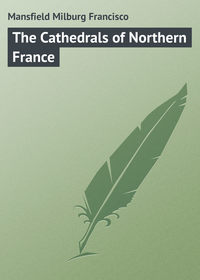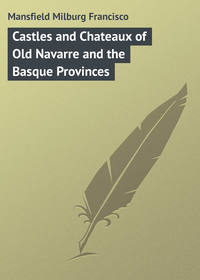 полная версия
полная версияThe Cathedrals and Churches of the Rhine

Francis Miltoun
The Cathedrals and Churches of the Rhine
The Rhine provinces stand for all that is best and most characteristic of the ecclesiastical architecture of Germany, as contrasted with that very distinct species known as French pointed or Gothic.
For this reason the present volume of the series, which follows the Cathedrals of Northern and Southern France, deals with a class of ecclesiastical architecture entirely different from the light, flamboyant style which has made so many of the great cathedral churches of France preëminently famous.
Save Cologne, there is no great cathedral, either in Germany or the Low Countries, which in any way rivals the masterpieces of Paris, Reims, or Amiens, or even Lincoln or York in England.
Strasburg and Metz are in a way reminiscent of much that is French, but in the main the cathedrals and churches of the Rhine are of a species distinct and complete in itself.
Any consideration of the Rhine cities and towns, and the ecclesiastical monuments which they contain, must perforce deal largely with the picturesque and romantic elements of the river's legendary past.
Not all of these legends deal with mere romance, as the world well knows. The religious element has ever played a most important part in the greater number of the Rhine legends. For demonstration, one has only to recall the legends of "The Architect of Cologne," of "Bishop Hatto and His Mouse Tower on the Rhine," and of many others relating to the devout men and women who in times past lived their lives here.
In the Low Countries also, – at Liège, where we have "The Legend of the Liègeois," and at Antwerp, where we have "The Legend of the Blacksmith," – and indeed throughout the whole Rhine watershed there is abundant material to draw from with respect to the religious legend alone.
As for the purely romantic legends, like "The Trumpeter of Sackingen" and "The Lorelei," there is manifestly neither room nor occasion for recounting them in a work such as this, and so, frankly, they are intentionally omitted.
In general, this book aims to be an account of the great churches in the Rhine valley, and of that species of architectural style which is known as Rhenish.
There is a fund of interesting detail to be gathered in out-of-the-way corners in regard to these grand edifices and their pious founders, but not all of it can be even catalogued here. The most that can be attempted is to point out certain obvious facts in connection with these ecclesiastical monuments, not neglecting the pictorial representation as well.
Tourists have well worn the roads along both banks of the Rhine, from Cologne to Mayence, but above and below is a still larger and no less interesting country, which has been comparatively neglected.
Not all the interest of the Rhine lies in its castled crags or its vine-clad slopes, and not all the history of the middle ages emanated from feudal strongholds. The Church here, as in France, played its part and played it gloriously.
In this discussion of the Rhine churches from Constance to Leyden, the reader will be taken on what might, with considerable license, be called an "architectural tour" of the Rhine, and will be allowed to ramble along the banks of the river, looking in and out of the various religious edifices with which its cities and towns are crowded.
The valley of the Rhine is no undiscovered land, but it served the purpose of the author and the artist well, for it presents much variety of architectural form, and an abounding and appealing interest by reason of the shadows of the past still lingering over these monuments in stone.
I
INTRODUCTORY
There is no topographical division of Europe which more readily defines itself and its limits than the Rhine valley from Schaffhausen to where the river empties into the North Sea.
The region has given birth to history and legend of a most fascinating character, and the manners and customs of the people who dwell along its banks are varied and picturesque.
Under these circumstances it was but to be expected that architectural development should have expressed itself in a decided and unmistakable fashion.
One usually makes the Rhine tour as an interlude while on the way to Switzerland or the Italian lakes, with little thought of its geographical and historical importance in connection with the development of modern Europe.
It was the onward march of civilization, furthered by the Romans, through this greatest of natural highways to the north, that gave the first political and historical significance to the country of the Rhine watershed. And from that day to this the Rhenish provinces and the Low Countries bordering upon the sea have occupied a prominent place in history.
There is a distinct and notable architecture, confined almost, one may say, to the borders of the Rhine, which the expert knows as Rhenish, if it can be defined at all; and which is distinct from that variety of pre-Gothic architecture known as Romanesque.
It has been developed mainly in the building of ecclesiastical edifices, and the churches and cathedrals of the Rhine valley, through Germany and the Netherlands, are a species which, if they have not the abounding popular interest of the great Gothic churches of France, are quite as lordly and imposing as any of their class elsewhere. The great cathedral at Cologne stands out among its Gothic compeers as the beau-ideal of our imagination, while the cathedral at Tournai, in Belgium – which, while not exactly of the Rhine, is contiguous to it – is the prototype of more than one of the lesser and primitive Gothic cathedrals of France, and has even lent its quadruple elevation to Notre Dame at Paris, and was possibly the precursor of the cathedral at Limburg-on-Lahn.
From this it will be inferred that the builders of the churches of the Rhine country were no mere tyros or experimenters, but rather that they were possessed of the best talents of the time.
There is much of interest awaiting the lover of churches who makes even the conventional Rhine tour, though mostly the tourist in these parts has heretofore reserved his sentiments and emotions for the admiration of its theatrical-looking crags and castles, the memory of its legends of the Lorelei, etc., a nodding acquaintance with the castle of Heidelberg, and a proper or improper appreciation of the waterside beer-gardens of Cologne. For the most part the real romance and history of the Rhine, as it flows from its source in the Grisons to the North Sea, has been neglected.
There are a large number of persons who are content to admire the popular attractions of convention; sometimes they evoke an interest somewhat out of the ordinary, but up to now apparently no one has gone to the Rhine with the sole object of visiting its magnificent gallery of ecclesiastical treasures.
No one glows with enthusiasm at the mention of these Rhenish churches as they do for the Gothic marvels of France. It is, of course, impossible, in spite of Cologne, Speyer, and Strasburg, that they should supplant Reims, Amiens, Chartres, or Rouen in the popular fancy, to say nothing of real excellence; for these four French examples represent nearly all that is best in mediæval church architecture.
The Reformation in Germany, with its attendant unrest, accounts for a certain latitude and variety in the types of church fitments, as well as – in many cases – an unconventional arrangement or disposition of the fabric itself.
One thing is most apparent with regard to German churches in general, – the fittings and paraphernalia, as distinct from the constructive or decorative elements of the fabric, are far more ornate and numerous than in churches of a similar rank elsewhere. It is true that the Revolution played its part of destruction along the Rhine, but in spite of this there is an abundance of sculpture and other ornament still left.
Thus one almost always finds elaborate choir-stalls, screens, pulpits, and altar-pieces, of a quantity and excellence that contrast strongly with the severe outlines of the fabric which shelters them.
In connection with the architectural forms of the ecclesiastical buildings of a country must invariably be considered such secular and civic establishments as represent the state in its relation to the Church, and along the Rhine, as elsewhere on the continent of Europe, the past forms an inseparable link which still binds the two. Here, not only the public architecture, but the private, domestic architecture takes on forms which, varied though they are, belong to no other regions. They are, moreover, only to be judged at their true value when considered as a thing of yesterday, rather than of to-day.
That portion of the Rhine which is best worth knowing, according to the ideas of the conventional tourist, is that which lies between Cologne and Mayence. This is the region of the travel-agencies, and of the droves of sightseers who annually sweep down upon the "legendary Rhine," as they have learned to call it, on foot, on bicycle, and by train, steamboat, and automobile.
Above and below these cities is a great world of architectural wealth which has not the benefit of even a nodding acquaintance with most new-century travellers.
To them Strasburg is mostly a myth, though even the vague memory of the part it played in the Franco-Prussian war ought to stamp it as something more than that, to say nothing of its awkwardly spired, but very beautiful and most ancient cathedral.
Still farther down the river one comes to Düsseldorf, that most modern of German cities. At Neuss, a short distance from Düsseldorf, is the church of St. Quirinus, which will live in the note-books of architectural students as one of the great buildings of the world.
It is a singularly ample river-bottom that is drained by the Rhine from its Alpine source to the sea, and one which offers practically an inexhaustible variety of charming environment; and here, as elsewhere, architecture plays no small part in reflecting the manners, customs, and temperaments of the people.
Of the value of the artistic pretensions of the people of Holland we have mostly obtained our opinions from the pictures of Teniers, or from the illustrated post-cards, which show clean-looking maidens bedecked in garments that look as though they had just been laundered. To these might be added advertisements of chocolate and other articles which show to some extent the quaint windmills and dwelling-houses of the towns. Apart from these there is little from which to judge of the wealth of architectural treasures of this most fascinating of countries, whose churches, if they are bare and gaunt in many ways, are at least as sympathetic in their appealing interest as many situated in a less austere climate. To realize this one has but to recall the ship-model-hung Kerk at Haarlem; the quaint little minaret which rises above the roof tops of Leyden; or, the grandest of all, the Groote Kerk of Rotterdam, which, on a cloud-riven autumn day, composes itself into varying moods and symphonies which would have made Whistler himself eager and envious of its beauty and grandeur.
In so far as this book deals only with the churches and cathedrals of the Rhine, and follows the course of the Neder Rijn and the Oud Rijn through Holland, there are but three Dutch cities which bring themselves naturally into line: Arnheim, Utrecht, and Leyden.
So far as Americans are concerned, there is a warm spot in their hearts for Old Holland, when they remember the brave little band of Pilgrims who gathered at Leyden and set sail from Delfthaven for their new home across the seas. This was but three hundred years ago, which, so far as the antiquity of European civilization goes, counts for but little. It is something, however, to realize that the mediæval architectural monuments of these places are the very ones which the Pilgrims themselves knew. It is true, however, that their outlook upon life was too austere to have allowed them to absorb any great amount of the artistic expression of the Dutch, but they must unquestionably have been impressed with the general appropriateness of the architecture around them.
Below Düsseldorf the topography and architectural features alike change rapidly, and the true Rhenish architecture of heavy arches, with an occasional sprinkling of fairy-like Gothic, really begins. Neuss, Essen, and all the Westphalian group of solidly built münsters speak volumes for German mediæval church architecture, while up the Rhine, past Düsseldorf, Cologne, Bonn, Königswater, Remagen, Sinzig, Andernach, Coblenz, and all the way to Mayence, and on past Schaffhausen to Basel are at least three score of interesting old churches as far different from those elsewhere as could possibly be imagined, and yet all so like, one to another, that they are of a species by themselves; all except the cathedral at Cologne, which follows the best practice of the French, except that its nave is absurdly short for its great breadth, and that its ponderous towers stand quite alone in their class.
In general, then, the cathedrals and churches of the Rhine form a wonderful collection of masterpieces of architectural art with which most well-informed folk in the world to-day should have a desire for acquaintanceship.
These often austere edifices, when seen near by, may not appeal to the popular fancy as do those of France and England, and they may not even have the power to so appeal; but, such as they are, they are quite as worthy of serious consideration and ardent admiration as any structures of their kind in existence, and they have, in addition, an environment which should make a journey among them, along the banks of the Rhine from its source to the sea, one of the most enjoyable experiences of life.
The Rhine loses none of its charms by intimate acquaintance; its history and legends stand out with even more prominence; and the quaint architectural forms of its cities are at least characteristically convincing.
Remains of every period may be found by the antiquary, from the time when the Roman eagle was triumphant throughout the dominion of the Franks to feudal and warlike times nearer our own day.
In addition, there are ever to be found evidences of the frugality and thrift of the Germans which preserve the best traditions of other days.
The love of the Rhineland in the breast of the Teuton is an indescribable sentiment; a confusion of the higher and lower emotions. It is characteristic of the national genius. We have been told, and rightly: "You cannot paint the Rhine, you cannot even describe it, for picture or poem would leave out half of the whole delicious confusion. The Rhine, however, can be set to music," and that apparently is just what has been done.
Everywhere one hears the music of the fatherland. Whether it is the songs and madrigals of the Church, or of the German bands in the Volksgarten, it is always the same, a light, irrepressible emotion which does much toward elucidating the complex German character.
Nowhere more than at Cologne is this contrast apparent. It is the most delightful of all Rhine cities. Usually tourists go there, or are sent there – which is about what it amounts to in most cases – in order to begin their "Rhine tour."
Before they start up-stream, they stroll about the city, pop in and out of its glorious cathedral, and perhaps one or another of its magnificent churches, – if they happen to be on their line of march to or from some widely separated points, – make the usual purchase of real eau de Cologne, – though doubtless they are deceived into buying a poor imitation, – and wind up in a river-side concert-garden, with much music and beer-drinking in the open.
This is all proper enough, but this book does not aim at recounting a round of these delights. It deals, if not with the Teutonic emotions themselves, at least with the expression of them in the magnificent and picturesquely disposed churches of both banks of the Rhine, from its source to the sea.
II
THE RHINE CITIES AND TOWNS
Cæsar, Charlemagne, and Napoleon all played their great parts in the history of the Rhine, and, in later days, historians, poets, and painters of all shades of ability and opinion have done their part to perpetuate its glories.
The Rhine valley formed a part of three divisions of the ancient Gaul conquered by the Romans: La Belgica, toward the coast of the North Sea; Germanica I., with Moguntiacum (Mayence) as its capital; and Germanica II., with Colonia Agrippina (Cologne) as its chief town. The Rhine was the great barrier between the Romans and the German tribes, and, in the time of Tiberius, eight legions guarded the frontier. The political and economic influences which overflowed from the Rhine valley have been most momentous.
The Rhine formed one of the great Roman highways to the north, and it is interesting to note that the first description of it is Cæsar's, though he himself had little familiarity with it. He wrote of the rapidity of its flow, and built, or caused to be built, a wooden bridge over it, between Coblenz and Andernach.
In the history of the Rhine we have a history of Europe. A boundary of the empire of Cæsar, it afterward gave passage to the barbarian hordes who overthrew imperial Rome. Charlemagne made it the outpost of his power, and later the Church gained strength in the cities on its banks, while monasteries and feudal strongholds rose up quickly one after another. Orders of chivalry were established at Mayence; and knights of the Teutonic order, of Rhodes, and of the Temple, appeared upon the scene. The minnesinger and the troubadour praised its wines, told of its contests, and celebrated its victories. The hills, the caves, the forests, the stream, and the solid rocks themselves were tenanted by superstition, by oreads, mermaids, gnomes, Black Huntsmen, and demons in all imaginable fantastic shapes.
Meantime the towns were growing under the influence of trade, – the grimy power that destroyed the feudal system. The Reformed religion found an advocate at Constance in John Huss even before Luther fulminated against Rome; printing was accomplished by Gutenberg at Mayence; and now steam and electricity have awakened a new era.
Cæsar, Attila, Clovis, Charlemagne, Frederick Barbarossa, Rudolph of Hapsburg, the Palatine Frederick the First, Gustavus Adolphus, and Napoleon have been victorious upon its banks. What more could fate do to give the stream an almost immortality of fame?
Little by little there were established on the banks of the river populous posts and centres of commerce. The military camps of Drusus had grown into settled communities, until to-day are found along the Rhine the great cities of Basel, Strasburg, Speyer, Worms, Mayence, Coblenz, Cologne, and Düsseldorf, and between them are dotted a series of cities and towns less important only in size, certainly not in the magnitude of their interest for the traveller or student, nor in their storied past.
Of the more romantic, though perhaps not more picturesque, elements of vine-clad slopes – where is produced the celebrated Rheinwein– the rapid flow of Rhine water, and the fabled dwelling-places of sprites and Rhinemaidens, there is quite enough for many an entertaining volume not yet written.
After traversing several of the cantons, the Rhine leaves Switzerland at Basel, on its course, through Germany and Holland, to the sea. Its chief tributaries are the Neckar, Murg, Kinzig, Aar, Main, Nahe, Lahn, Moselle, Erft, Ruhr, and Lippe. Its waters furnish capital salmon, which, curiously enough, when taken on their passage up the stream, are called lachse; but, when caught in autumn on their way down to the sea, are known as salmon. It affords also sturgeon, pike, carp, and lampreys. Its enormous rafts of timber have often been described, and should be seen to be appreciated. They often carried half a village of people, and were of great value. To-day these great rafts, however, are seldom seen.
In summer, when the tourist visits the river, its course is comparatively calm and orderly; it is only in spring, when the snows melt rapidly in Switzerland, that "Father Rhine" is to be beheld in all his might; for then the waters often rise a dozen feet above their common level. Its depth from Basel to Strasburg averages ten to twelve feet; at Mayence, twenty-four feet; at Düsseldorf, fifty feet.
To Basel, through the Lake of Constance from Grisons, the Rhine forms a boundary between Switzerland and the German States. From Basel to Mayence it winds its way through the ancient bed of the glaciers; and from Mayence to Bingen it flows through rocky walls to Bonn, where it enters the great alluvial plain through which it makes its way to the ocean.
The valley of the Rhine has been called the artery which gives life to all Prussia. The reason is obvious to any who have the slightest acquaintance with the region. The commerce of the Rhine is ceaseless; day and night, up and down stream, the procession of steamboats, canal-boats, floats, and barges is almost constant.
From the dawn of history both banks of the Lower Rhine had belonged to Germany, and they are still inhabited by Germans. Ten centuries or more have elapsed since the boundaries of the eastern and western kingdom of the Franks were fixed at Verdun, and, though the French frontier had frequently advanced toward Germany, and at certain points had actually reached the Rhine, no claim was advanced to that portion which was yet German until the cry of "To the Rhine" resounded through the French provinces in 1870-71.
Of course the obvious argument of the French was, and is, an apparently justifiable pretension to extend France to its natural frontier, but this is ill-founded on precedent, and monstrous as well. Against it we have in history that a river-bed is not a natural delimitation of territorial domination.
The Cisalpine Gauls extended their powers across the river Po, and the United States of America first claimed Oregon by virtue of the interpretation that a boundary at a river should give control of both banks, though how far beyond the other bank they might claim is unestablished.
Until the Lake of Constance is reached, with its fine city of the same name at its westerly end, there are no cities, towns, or villages in which one would expect to find ecclesiastical monuments of the first rank; indeed, one may say that there are none.
But the whole Rhine watershed, that great thoroughfare through which Christianizing and civilizing influences made their way northward from Italy, is replete with memorials of one sort or another of those significant events of history which were made doubly impressive and far-reaching by reason of their religious aspect.
The three tiny sources of the Rhine are born in the canton of Grisons, and are known as the Vorder-Rhein, the Mittel-Rhein, and the Hinter-Rhein.
At Disentis was one of the most ancient Benedictine monasteries of the German Alps. It was founded in 614, and stood high upon the hillside of Mount Vakaraka, at the confluence of two of the branches of the Rhine. Its abbots had great political influence and were princes of the Empire. They were the founders of the "Gray Brotherhood," and were the first magistrates of the region.
The abbey of Disentis was, in 1799, captured and set on fire by the French, but later on it was reëstablished, only to suffer again from fire in 1846, though it was again rebuilt in more modest style.
St. Trons was the former seat of the Parliament of Grisons. Its chief ecclesiastical monument is a memorial chapel dedicated to St. Anne.
On its porch one may read the following inscription:
"In libertatem vocati estisUbi spiritus domini, ibi libertasIn te speraverunt patresSperaverunt et liberasti oes."Coire was the ancient Curia Rhætiorum. It is the capital of the Canton of Grisons, and was the seat of a bishop as early as 562. The Emperor Constantine made the town his winter quarters in the fourth century.
The church of St. Martin, to-day belonging to the Reformed Church, is an unconvincing and in no way remarkable monument, but in what is known as the Episcopal Court, behind great walls, tower-flanked and with heavily barred gateways, one comes upon evidences of the ecclesiastical importance of the town in other days.











